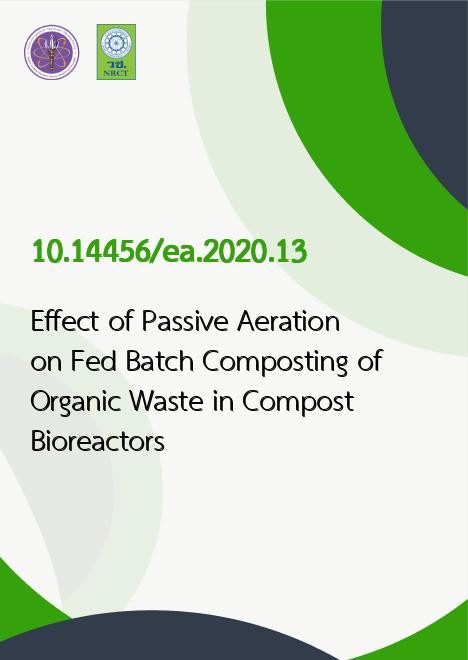
|
Effect of Passive Aeration on Fed Batch Composting of Organic Waste in Compost Bioreactors |
|---|---|
| รหัสดีโอไอ | |
| Creator | 1. Isara Prohmdetbun 2. Thares Srisatit |
| Title | Effect of Passive Aeration on Fed Batch Composting of Organic Waste in Compost Bioreactors |
| Publisher | Thai Society of Higher Education Institutes on Environment |
| Publication Year | 2563 |
| Journal Title | EnvironmentAsia |
| Journal Vol. | 13 |
| Journal No. | 1 |
| Page no. | 140-149 |
| Keyword | Food waste composting, Passive aeration, Fed batch composting |
| URL Website | http://www.tshe.org/ea/index.html |
| Website title | EnvironmentAsia |
| ISSN | 1906-1714 |
| Abstract | The objective of this research is to determine the effect of air on the degradation of food waste using compost bioreactors with different passive aeration. The bioreactor was made of 200L PE plastic container. There were 5 bioreactors identified by different ratios of air volume as 0%, 2.3%, 3%, 4.3% and 5.7% of bioreactors volume or 0, 1, 2, 4 and 6 PVC pipes of diameter 1_ำ, respectively. The Fed Batch Composting (FBC) method was used, adding for once per a bioreactor at amount 85 kilograms of materials. The experiment was also subdivided into 2 types: bioreactors with microbes (PD2); and those without microbes. Temperature, moisture content, and pH were measured. Compost samples were analyzed for their germination index (GI) and quality, then compared with the Thailand compost standards. The research output showed that the optimum air volume for composting was 4.3% of bioreactor volume, or 4 pipes. The composting time was 9 days with the highest temperature of 58-59 กC and the temperature was held constantly for 18 days. The organic waste decomposition and curing took a total of 30 days, with a GI value between 85% and the quality of the fertilizer output complied with the Thailand compost standard. The main minerals of the compost were N, P and K, which were 1.57%, 0.87% and 0.75%, respectively. There was no statistically significant difference between the outputs generated from the compost with and without addition of PD2. |